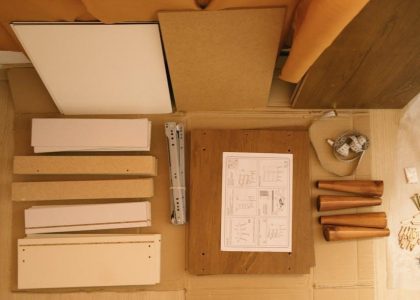The Vermont Casting Radiance Gas Stove is a high-efficiency appliance designed to provide warmth and ambiance with a realistic flame effect. This manual is essential for safe installation, operation, and maintenance.
1.1 Overview of the Vermont Casting Radiance Gas Stove
The Vermont Casting Radiance Gas Stove is a high-efficiency, natural vent gas stove designed to provide reliable heat and a realistic flame experience. Its robust construction ensures durability, while its sleek design complements various home décors. The stove operates with a manual pilot light system, requiring precise steps for safe ignition. Proper installation, including venting and gas line connections, is crucial for optimal performance and safety. This manual serves as a comprehensive guide, covering operation, maintenance, and troubleshooting to ensure users maximize efficiency while minimizing risks; Adhering to the instructions is essential for a safe and enjoyable experience with the Radiance Gas Stove.
1.2 Importance of the Manual for Safe and Efficient Operation
The manual is crucial for operating the Vermont Casting Radiance Gas Stove safely and efficiently. It provides detailed instructions for pilot lighting, gas leak detection, and venting requirements. Following the guidelines ensures proper functionality and prevents hazards like carbon monoxide exposure. Regular maintenance steps, such as cleaning and part inspections, are outlined to maintain performance. The manual also includes troubleshooting tips for common issues, like pilot light failures, helping users resolve problems quickly. By adhering to the manual, users can enjoy a safe, efficient, and long-lasting experience with their Radiance Gas Stove, minimizing risks and optimizing heating performance.
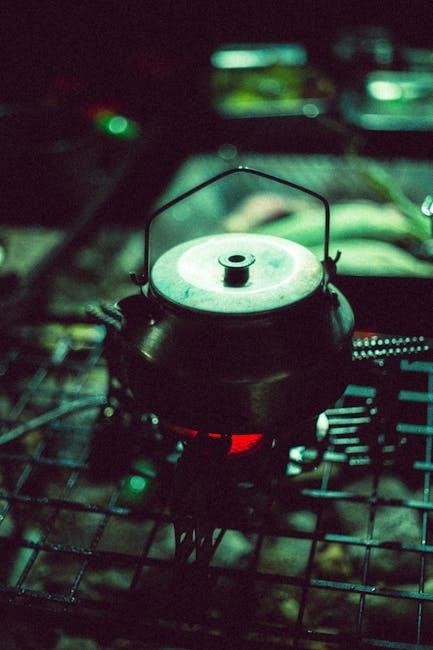
Key Features of the Vermont Casting Radiance Gas Stove
The Vermont Casting Radiance Gas Stove offers a sleek design, high heat output, energy efficiency, and advanced safety features, ensuring reliable performance and environmental benefits.
2.1 Design and Build Quality
The Vermont Casting Radiance Gas Stove is renowned for its exceptional design and durability. Built with high-quality materials, including heavy-duty steel, it ensures long-lasting performance. The stove features a sleek, modern aesthetic with a realistic flame presentation, enhancing home decor. Its sturdy construction includes a robust heat exchanger and a durable finish, resistant to wear and tear. Safety is prioritized with a manual pilot light system and strong, heat-resistant glass. The design also incorporates energy-efficient technology, optimizing warmth while minimizing emissions. This combination of style, strength, and functionality makes it a reliable choice for home heating.
2.2 Heat Output and Efficiency
The Vermont Casting Radiance Gas Stove delivers impressive heat output, ranging from 20,000 to 40,000 BTUs, ensuring consistent warmth for various room sizes. Its advanced combustion technology maximizes efficiency, achieving an Annual Fuel Utilization Efficiency (AFUE) rating of up to 80%. The stove features a direct vent system, which optimizes heat retention and reduces energy loss. With variable heat control, users can adjust the flame height and output to match their needs, enhancing energy savings. This balance of power and efficiency makes it an excellent choice for reliable and cost-effective home heating.
2.3 Safety Features
The Vermont Casting Radiance Gas Stove incorporates multiple safety features to ensure secure operation. An oxygen depletion sensor monitors the air quality and shuts off the stove if carbon monoxide levels rise. The automatic shut-off valve halts gas flow if the pilot light fails. A sealed combustion chamber contains the flame, preventing hazardous fumes from entering the room. Heat-resistant glass protects users from burns. Child safety locks prevent unintended ignition. Regular maintenance and annual inspections are essential to uphold these safety standards, ensuring the stove functions efficiently and safely to ensure many years.

Installation Requirements and Considerations
Proper installation is crucial for safe and efficient operation. Ensure compliance with local codes, adequate venting, and correct gas line connections. Hire a certified professional for setup.
3.1 Pre-Installation Checks
Before installation, inspect the stove for damage and ensure all components are included. Verify the installation location meets clearance requirements and is near a suitable venting system. Check local building codes and ensure a dedicated gas line is available. Measure the space to confirm the stove fits properly. Ensure electrical connections are accessible if required. Test the gas line for leaks using soap solution. Confirm the chimney or venting system is compatible and in good condition. Review the manual to ensure all safety guidelines are understood. Proper preparation ensures a smooth and safe installation process.
3.2 Venting and Clearance Requirements
Proper venting is essential for safe operation. Use a direct vent system for sealed combustion or a B-vent for natural draft. Install vents with approved materials, ensuring they meet local codes. Maintain minimum clearances: 36 inches from combustible materials in front, 12 inches on sides, 48 inches above, and 24 inches behind. Ensure vents are securely installed, insulated, and free of leaks. Horizontal vent runs should not exceed 20 feet, and vertical runs should not exceed 40 feet. Always follow local building codes and manufacturer guidelines for optimal performance and safety. Proper venting prevents carbon monoxide risks and ensures efficient burning; Consult a professional if unsure.
3.3 Gas Line Installation and Connections
Gas line installation must be performed by a licensed professional to ensure safety and compliance with local codes. Use only approved, corrosion-resistant materials like certified copper or steel tubing. The gas line should be sized correctly based on the stove’s BTU rating and distance from the supply. Ensure all connections are secure and leak-tested using soap solution or approved detectors. Follow the manufacturer’s guidelines for routing and avoid bends or restrictions. Install a shut-off valve within 6 feet of the stove for easy access. Always adhere to local regulations and safety standards to prevent gas leaks or hazards. Proper installation ensures reliable and safe operation.

Operating the Vermont Casting Radiance Gas Stove
Operating the stove involves simple steps for ignition, heat adjustment, and monitoring. Always follow safety guidelines and manufacturer instructions for optimal performance and efficiency.
4.1 Starting the Stove: Pilot Lighting Instructions
To start the Vermont Casting Radiance Gas Stove, locate the pilot assembly. Turn the control knob to the “Pilot” position and press and hold until the pilot ignites. Ensure the pilot stays lit for at least 30 seconds before releasing. If the pilot doesn’t light, wait 5 minutes and try again. Always follow safety guidelines and avoid using open flames if the pilot fails to ignite. Refer to the troubleshooting section for further assistance if issues persist. Proper ignition ensures safe and efficient operation of the stove.
4.2 Adjusting Heat Output and Flame Height
Adjusting the heat output and flame height on the Vermont Casting Radiance Gas Stove is done using the control knob. Turn the knob to the desired heat setting, ranging from low to high. The flame height will automatically adjust based on the selected setting. For precise control, gently press the knob to fine-tune the flame. Always ensure the flame is steady and blue, indicating proper combustion. Avoid manually adjusting the flame height, as this could disrupt safe operation. Adjustments should only be made when the stove is in operation to maintain optimal performance and safety.
4.3 Understanding Control Knobs and Functions
The Vermont Casting Radiance Gas Stove features intuitive control knobs that regulate stove operation. The primary knob controls ignition and heat output, while a secondary knob adjusts flame height. The knobs are designed for smooth operation, allowing precise control over the stove’s performance. Some models include a child safety lock to prevent accidental ignition. Always refer to the manual for specific knob functions, as designs may vary. Proper use of the control knobs ensures safe and efficient operation. Never force the knobs, as this could damage the mechanism. Regularly clean the knobs to maintain responsiveness and functionality.
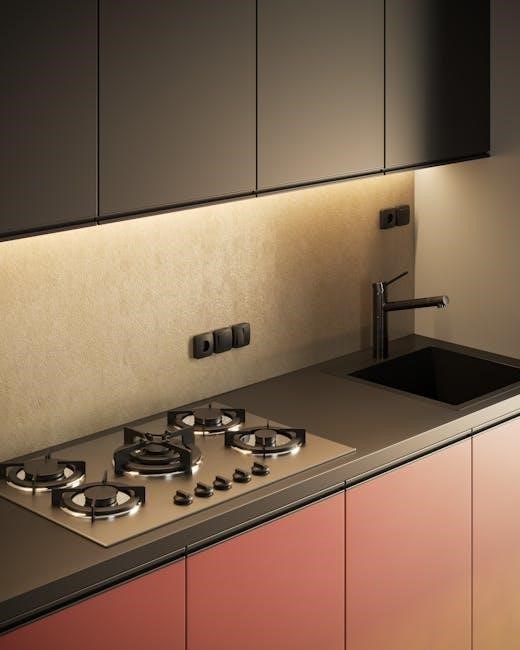
Maintenance and Upkeep
Regular maintenance ensures optimal performance and safety. Clean surfaces, check for blockages, and inspect gas lines. Schedule annual servicing by a qualified technician. Refer to the manual for detailed maintenance schedules.
5.1 Cleaning the Stove and Glass Surfaces
Clean the stove regularly to maintain efficiency and appearance. Turn off the stove and allow it to cool completely. Use a soft brush or vacuum to remove dust and debris from vents and surfaces. For glass surfaces, apply a glass cleaner specifically designed for fireplace or stove glass. Avoid abrasive materials that may scratch the finish. Wipe down the exterior with a damp cloth, ensuring no chemicals or harsh cleaners are used. Clean burner ports with a small brush to ensure proper gas flow. Regular cleaning prevents corrosion and maintains optimal performance. Always refer to the manual for recommended cleaning products and methods.
5.2 Checking and Replacing Parts (e.g., Batteries, Ignition Components)
Regularly inspect and maintain stove components to ensure reliable operation. Check the battery in the ignition system every 6 months and replace it if it shows signs of weakness or corrosion. Inspect ignition components, such as electrodes and spark plugs, for wear or damage. Clean or replace these parts as needed to maintain proper ignition. If you notice issues like inconsistent sparking or failure to ignite, consult the manual for replacement procedures. Always use genuine Vermont Casting replacement parts to ensure compatibility and safety. If unsure, contact an authorized service technician for assistance.
5.3 Annual Inspection and Servicing Recommendations
Annual inspections are crucial for maintaining the Vermont Casting Radiance Gas Stove’s performance and safety. Hire a qualified technician to examine the venting system, heat exchanger, and burner components for wear or damage. Ensure all connections are secure and functioning properly. Clean or replace air intake filters as needed to optimize airflow. Additionally, inspect the ignition system and gas valve for proper operation. Schedule servicing before the heating season to prevent issues. Regular maintenance ensures efficient operation, safety, and extends the stove’s lifespan. Always follow the manufacturer’s guidelines for inspections and servicing.
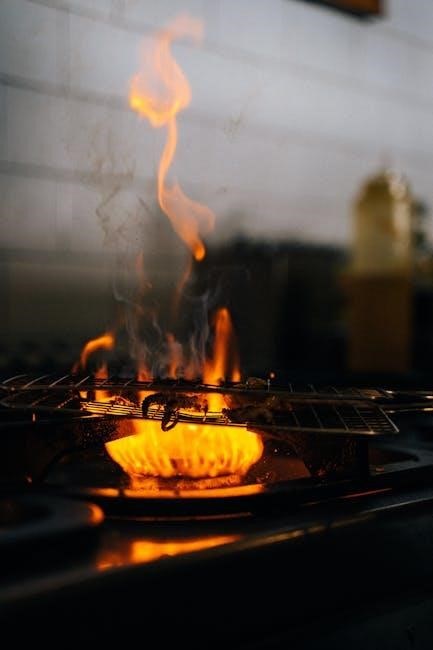
Troubleshooting Common Issues
Troubleshooting common issues with the Vermont Casting Radiance Gas Stove involves addressing pilot light problems, low heat output, strange noises, and error codes. Check gas supply, ensure proper ventilation, inspect burners for blockages, and reset the stove if necessary. Always refer to the manual for specific guidance or contact customer support for persistent problems.
6.1 Pilot Light Issues: Failure to Ignite or Stay Lit
For pilot light issues on your Vermont Casting Radiance Gas Stove, first check the gas supply by ensuring the valve is fully open. If the pilot light still doesn’t ignite or stays lit, inspect for blockages in the pilot orifice and clean it if necessary; If the igniter isn’t sparking, test and replace the spark electrode. Ensure the thermocouple is properly connected and functioning. If problems persist, verify that the stove is properly vented. Always follow safety guidelines and consult a qualified technician if issues remain unresolved.
- Check the gas supply and ensure the valve is fully open.
- Inspect and clean the pilot orifice if blocked.
- Test and replace the spark electrode if faulty.
- Ensure the thermocouple is connected and functioning correctly.
- Verify proper ventilation around the stove.
- Consult a qualified technician if issues persist.
6.2 Low or Inconsistent Heat Output
If your Vermont Casting Radiance Gas Stove produces low or inconsistent heat, check for blockages in the air intake or venting system. Ensure proper clearance around the stove and verify that no debris is obstructing the burner orifice. Adjust the gas pressure if necessary, as improper settings can affect heat output. Inspect the heat exchanger for damage or corrosion and ensure it is functioning correctly. If issues persist, consult the manual or contact a certified technician to diagnose and repair any underlying problems.
- Check for blockages in the air intake or venting system.
- Ensure proper clearance around the stove.
- Inspect and clean the burner orifice if clogged.
- Verify gas pressure settings and adjust if necessary.
- Inspect the heat exchanger for damage or corrosion.
6.3 Strange Noises or Smells
Strange noises or unpleasant odors from your Vermont Casting Radiance Gas Stove may indicate underlying issues. If you hear unusual sounds, such as rattling or hissing, inspect the burner orifice for blockages or debris. For smells, ensure proper venting and check for gas leaks using a gas leak detector. If the odor persists, verify that the stove is installed correctly and that all connections are secure. Consult the manual for diagnostic procedures or contact a professional if the issue remains unresolved.
- Inspect the burner orifice for blockages.
- Check for gas leaks using a detector.
- Ensure proper installation and venting.
- Consult the manual for diagnostic guidance.
- Contact a professional if issues persist.

Safety Precautions and Guidelines
Always follow safety guidelines to ensure safe operation of your Vermont Casting Radiance Gas Stove. Proper ventilation is essential to prevent carbon monoxide buildup.
- Keep flammable materials away from the stove.
- Never leave the stove unattended while in operation.
- Ensure children and pets maintain a safe distance.
7.1 Gas Leak Detection and Prevention
Regularly inspect gas lines and connections for signs of wear or damage. Use a soapy water solution to check for bubbles, which indicate leaks. Turn off the gas supply immediately if a leak is detected and ventilate the area. Never attempt repairs yourself; contact a qualified technician. Install gas detectors to alert you of potential leaks. Always follow the manufacturer’s guidelines for gas line maintenance and ensure all connections are secure. Preventive measures, like annual inspections by a professional, can help avoid gas-related hazards. Safety should always be your top priority when dealing with gas appliances.
7.2 Carbon Monoxide Safety
Carbon monoxide (CO) is a colorless, odorless gas that can be deadly in high concentrations. Ensure proper venting of your Vermont Casting Radiance Gas Stove to prevent CO buildup. Never operate the stove with a blocked or damaged vent system. Install a CO detector in your home, especially near sleeping areas. If you experience headaches, dizziness, or nausea, turn off the stove, open windows, and leave the area immediately. Annual inspections by a qualified technician can help ensure safe operation and prevent CO risks. Always follow venting guidelines provided in the manual to maintain a safe environment.
7.4 Child and Pet Safety Around the Stove
Ensure child and pet safety by maintaining a safe distance from the Vermont Casting Radiance Gas Stove. Install a safety guard or barrier to prevent accidental contact with hot surfaces. Supervise children and pets when the stove is in operation. Teach children to never touch or play near the stove. Keep flammable materials, toys, and bedding away from the stove. Secure any loose clothing or long hair that could catch fire. Regularly inspect the stove for loose parts and ensure they are tightly secured. Consider trimming pet fur near the stove to prevent ignition hazards. Always prioritize creating a safe zone around the stove.
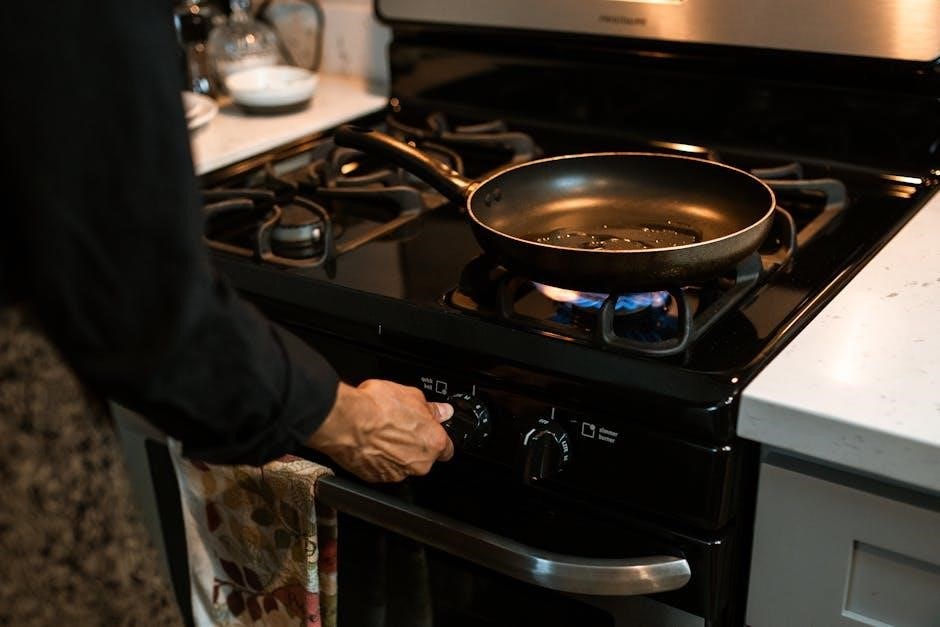
Warranty and Customer Support
The Vermont Casting Radiance Gas Stove is backed by a comprehensive warranty. For details and customer support, visit Vermont Castings’ official website or contact their support team.
8.1 Understanding the Warranty Terms and Conditions
The Vermont Casting Radiance Gas Stove comes with a limited warranty covering parts and labor for specific components. The burner and combustion chamber are typically warranted for 20 years, while other components like electrical parts and finishes may have shorter coverage periods, such as 5 or 1 year. Registration within 30 days of purchase is often required to activate the warranty. Damage caused by improper installation, misuse, or lack of maintenance may void coverage. Review the manual or contact Vermont Castings for detailed terms and conditions.
8.2 Contacting Vermont Castings Customer Service
Vermont Castings provides customer support to assist with inquiries, troubleshooting, and warranty claims. You can contact them via phone, email, or through their official website. The customer service team is available during business hours, Monday to Friday. For prompt assistance, have your stove model and serial number ready. Visit their website for contact details and support resources. Ensure to reach out to authorized service providers for repairs to maintain warranty validity and safety standards. Regular communication with Vermont Castings ensures optimal performance and addresses any concerns effectively.
8.3 Finding Authorized Service Providers
To ensure your Vermont Casting Radiance Gas Stove operates safely and efficiently, only use authorized service providers for repairs and maintenance. These professionals are trained to handle specific models and adhere to safety standards. Visit the Vermont Castings official website to find a certified dealer or service provider in your area. You can also contact customer service for recommendations. Additionally, local HVAC technicians may be authorized, but always verify their certification. Using unauthorized services may void your warranty and compromise safety. Always prioritize authorized providers for reliable and compliant service.

Environmental Considerations
The Vermont Casting Radiance Gas Stove is designed with energy efficiency in mind, reducing environmental impact. Proper disposal of old parts ensures responsible waste management and sustainability.
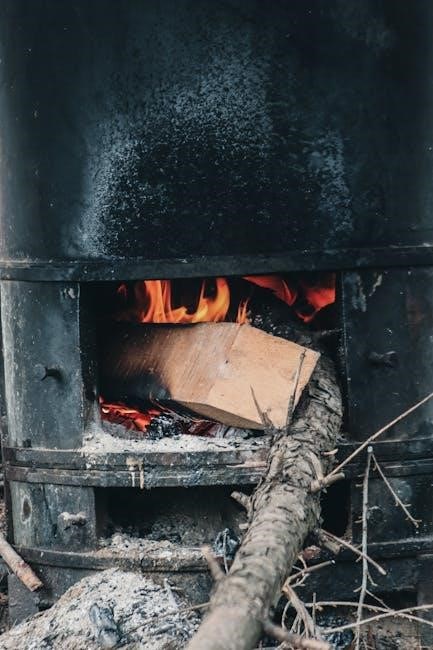
9.1 Energy Efficiency and Environmental Impact
The Vermont Casting Radiance Gas Stove is crafted with energy efficiency in mind, ensuring minimal environmental impact. Its advanced combustion technology reduces emissions, while its high fuel efficiency rating helps lower energy consumption. Designed to meet rigorous environmental standards, this stove contributes to a greener home heating solution. By utilizing natural gas cleanly and effectively, it minimizes carbon footprint compared to less efficient alternatives. These eco-conscious features make it an environmentally responsible choice for homeowners seeking to balance comfort and sustainability. Proper use and maintenance further enhance its energy-saving capabilities, aligning with eco-friendly practices.
9.2 Proper Disposal of Old or Damaged Parts
When replacing or upgrading parts of your Vermont Casting Radiance Gas Stove, proper disposal is essential to protect the environment. Old or damaged components, such as batteries or ignition parts, may contain hazardous materials. Verify local regulations for disposing of such items, as some require special handling. Metal parts can often be recycled, reducing waste. Always disconnect and safely package components to prevent accidental ignition or leakage. For guidance, consult your local waste management agency or an authorized service provider. Eco-friendly disposal ensures safety and minimizes environmental impact.
This manual has provided comprehensive guidance on safely operating and maintaining your Vermont Casting Radiance Gas Stove. By following these instructions, you ensure optimal performance, energy efficiency, and longevity. Always prioritize safety and routine maintenance for a reliable and enjoyable experience with your stove.
10.1 Summary of Key Points
10.2 Final Tips for Optimal Performance
To maximize the performance of your Vermont Casting Radiance Gas Stove, ensure regular maintenance, such as cleaning burners and vents. Always follow the recommended fuel types and avoid overloading the stove. Keep the surrounding area clear of flammable materials and ensure proper ventilation. Check for blockages in the venting system periodically. Maintain the glass surfaces clean for better heat distribution. Store extra fuel safely and away from the stove. By following these tips, you can enjoy consistent, efficient, and safe heating while prolonging the stove’s lifespan and ensuring peak performance year-round;



